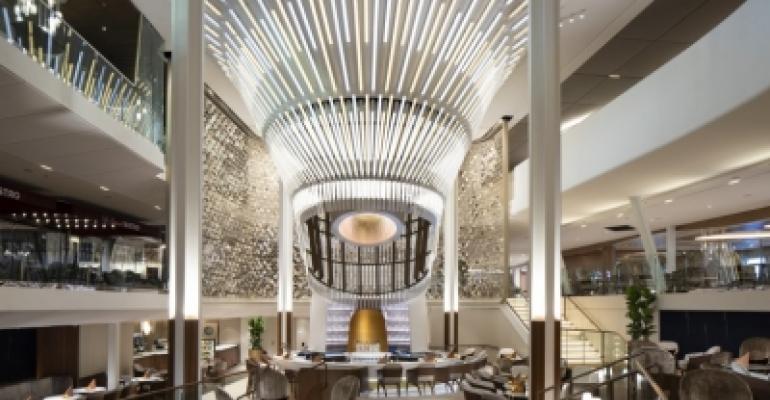‘We bring designers in who have not worked on cruise ships before as a fresh pair of eyes,’ said Dee Cooper, SVP of design, Virgin Voyages. ‘Our focus is on creating experiences and inspiring spaces,’ she said.
Aiming for a new customer
It’s important to continually generate new and exciting styles to keep engaging with the audience. ‘We’re aiming to cater to a new customer, offering a more experiential holiday on the water. We’ve set up a creative collective to design a range of spaces across the ship. Virgin is all about doing it differently. The scale of the ship can be overwhelming for guests so it’s a great challenge,’ Cooper said.
Good working partnerships are key to creating great design. ‘We work with partners like Fincantieri. We worked in collaboration to come up with a very different ship. We partnered with Giacomo Mortola, who acted as an architect of record,’ Cooper said.
Diversity of design plays a significant role in inspiring originality. As Paris Swann, director, newbuild architecture design, Royal Caribbean Cruises Ltd., advised: ‘Having a mix of veterans and virgins is part of Royal Caribbean culture. Eighty-five percent of the design is by new to cruise [veteran architects] who are not constrained by decades of experiences to create something different.’
Ship design is a complex mix of 'well architectured' spaces and innovative design, as Jan Krefting, senior architect, partner YSA Design, said: ‘A ship is like a city; you need to make sure you get the right flow of development concepts.’
For close collaborations to be successful there needs to be direction. ‘Virgin spent time listening, we had to put systems in place to ensure we put the Virgin stamp on it,' Cooper said. 'Each brand has different needs. The balance of experience and new thinking challenges how a ship is traditionally created.'
Time management, focus and the learning curve
Working with such a mix of experiences and backgrounds requires time and focus to get over the learning curve. ‘It’s a question of balance. There’s a lot of phases to the learning curve process,' Kreftig said. 'It’s very different from land-based building.
'Owners should use more time in planning what they want before they go to the yard,’ he added.
‘It’s a process. We have to consider how we evaluate safety and USPH regulatory questions. Involving new designers constantly challenges the offering,’ Swann continued. She added that working with many suppliers takes a high level of collaboration.
Bigger ships require more architects/designers
However, for Royal Caribbean, having a mix of professionals with different backgrounds creates varied and refreshing results. ‘We get a lot of new ideas from different architects,' Swann said. 'Ships are getting bigger and bigger so we need more architects and designers.'
The cruise industry must appeal to a wide audience and look to attract new people to remain competitive, she explained. ‘We must collaborate to push the industry forward to eliminate the stigma ... that cruises are for the older generation. We must create a trendy, cool environment to attract younger generations so that they want to go on a cruise ship, and to keep modern sailors happy.’
‘We like to think our sailors want us to do it differently. So, we want to create an environment like a high street to give customers choice. We want to offer an approach that is different and demanding of service,’ Swann added.
Following the panel discussion, Seatrade Cruise News spoke with design and engineering specialists Foreship, which offer a design feasibility consultancy service for newbuild and retrofitted cruise ships.
Mattias Jörgensen, VP business development, said, ‘Modernisation of cruise ships is becoming close to a $3 billion market. Owners are responding to demand to keep adding the wow factor to stay competitive. We see a lot of interest in things like water parks and upgrades. We also see a huge boom in the newbuild market.
But when retrofitting older ships there comes a different set of design challenges, as Jorgensen explained: ‘We have to evaluate the venue to ensure compliance with different regulatory elements like materials and health and safety.’
In a competitive market, new design ideas are constantly being created but each needs to be evaluated for feasibility. ‘Architects keep pushing the boundaries of design and what can be done on board.
‘New architects to the industry don’t have cruise expertise so it has to be a joint effort between naval architects and cruise industry architects to ensure the design is feasible and addresses compliance issues such as escape routes.
Helping speed up the process
‘We help to speed up the process. It’s all about efficiency and time management. We don’t see more time being given to projects. We help to speed up the architecture process as time needs to be utilised well across the design stages.
‘Cruise ship operators have to adapt to the pace or risk getting left behind,' Jörgensen added.
Copyright © 2024. All rights reserved. Seatrade, a trading name of Informa Markets (UK) Limited. Add Seatrade Cruise News to your Google News feed.


